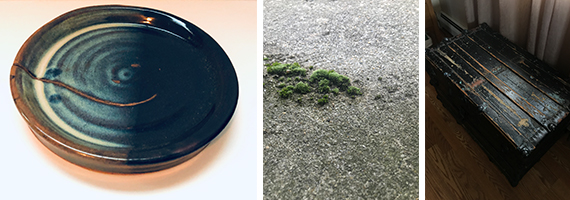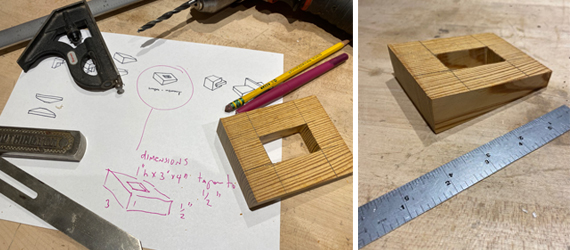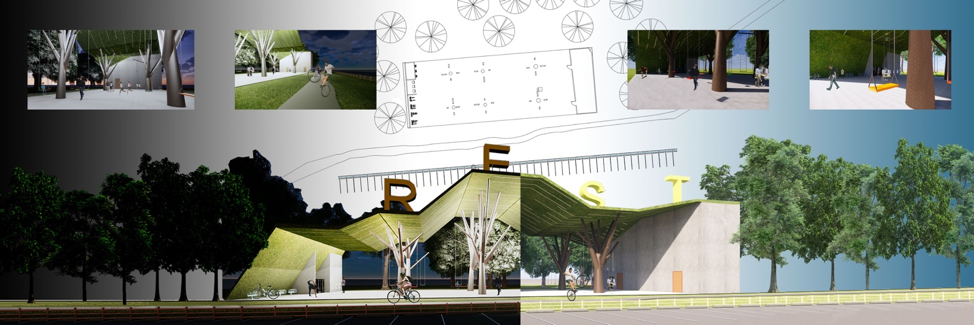Remote Teaching with Architecture, Design & Urbanism
April 23, 2020
In the Department of Architecture, Design & Urbanism, exploration of space and materials are essential, so moving to an entirely virtual environment is, in the words of Interior Design Assistant Professor Frances Temple-West, “challenging yet oddly liberating. It has opened up new opportunities to learn about materials and materiality.”
In Associate Professor Nicole Koltick's first year graduate Interior Architecture Studio A, students are designing spatial strategies that explore potentials for connection through separation in public spaces. For their first project, they are developing a public pavilion, which provides moments of respite, reflection and indirect connections with fellow visitors. Students have moved their work from highly communal making studios into their individual work spaces with an incredibly resilient and positive energy. In the studio, Nicole’s students use a broad array of digital tools to facilitate the viewing, critiquing and development of the projects. This intensive studio course requires the production of numerous physical models and drawings. From their home studios, students have transformed a wide array of prosaic materials into beautiful spatial propositions. Student Pooja Kalavagunta produced a series of models deploying bubble wrap and a very inventive method of injecting colored dye into the individual cells. She has transported an abundant yet humble material into a wonderfully poetic design proposition. Professor Koltick's course meets synchronously twice a week with all members of the class contributing to group discussion and critique of ongoing work. Throughout the course students share their models and drawings with the whole group during live Zoom sessions. They utilize screen sharing and markup tools to communicate through sketches on top of drawings and model images.

Found objects from Assistant Professor Frances Temple-West’s Material Investigations Class.
In Frances Temple-West’s Material Investigations Class for first-year graduate students of Interior Architecture & Design, students are encouraged to use their home environment as a means of physical material exploration. Frances introduced students to the quintessential Japanese aesthetic of Wabi-Sabi: the concept of finding beauty in imperfection, impermanence, and the modest and humble. The idea is to train the eye to appreciate and value the patina, luster and depth of character that objects and surfaces develop over time. To this end, the students took photos of objects in their homes that embodied these characteristics and qualities: a walnut, a wooden chest, handmade ceramics, moss on a concrete floor, and aged wooden beams.

Adjunct Faculty Jay Haon teaches Furniture Design remotely.
Jay Haon, who teaches Furniture Design, found an innovative way to provide his students an experience that mirrors industry practice. Because Interior Design majors are unable to access the fabrication labs on campus, they were asked to send detailed drawings and designs to Jay, who will act as fabricator. “This gives students something not all that different from a real world experience where a design would be sent to a shop or maker, and a good designer would gain an understanding of the connection between between designing and making through that relationship,” Jay said. He’ll then send fabricated parts to students for hands-on review and modification.

Ize Prize submission from Francesca “Frankie” Alchanati.
Departmental faculty are developing ways to create community and continue recognizing excellence in student creative work. The annual "Ize Prize" is named after the Steve Izenour, an architect, urbanist and theorist who worked closely with Robert Venturi and Denise Scott Brown. With them, he co-authored the phenomenally influential book, Learning from Las Vegas. He was also a much loved colleague and instructor in the Architecture program at Drexel. The Ize Prize encourages Architecture students to explore space, image, and graphics through the design of a small building. On a recent Saturday morning, with coffee cups in hand and, in some cases, unruly hair, the jury assembled on Zoom. There were serious deliberations, lighthearted banter, and a few questionable jokes, generally at each other’s expense. In other words, exactly as Steve would have wanted it. This year’s prize was awarded to Francesca “Frankie” Alchanati after a faculty deliberation via Zoom. Her lyrical, spacious and inviting design was a clear jury favorite. Frankie’s winning design, along with the entire excellent body of work produced by Architecture students, will be displayed on the online platform MURAL. Read more about the Ize Prize here.

Masters in Design Research (DSRE) students, alumni, faculty, and prospective students have been gathering every Friday online to discuss the current crisis, connect socially, and drink coffee together. Topics shared and discussed include current work by Alumni Nicole Feller-Johnson and Elise Krespan, with Product Design Alum Jared Therrien, and others, in a physical distancing labeling system. Jared has a start-up called Emergency Info Systems, and their project, Project Safe is supported through his startup in collaboration with a transdisciplinary, all-Drexel faculty and student team. They are offering indoor and outdoor labels, at no charge, to select life-sustaining businesses that require physical distancing indicators, and they already have hundreds of requests for their environmental signage solution. Thelmelis Abreu shared her efforts as a part-time researcher at the LG Health Center for Health Care Innovation, a local extension of the Penn Medicine Center for Health Care Innovation, in exploring and understanding alternative forms of personal protective equipment (PPE.) Paris Gramann, a research assistant for Program Director Dee Nicholas, has also shared ongoing efforts to support children and families’ mental health through her startup just be books, including a recent 20-day activity challenge for parents and kids to do at home. They are developing a book companion app through their social media. Claire King, a current DSRE Thesis student and researcher has shared her mask-making efforts, as well as updates on her ongoing work with the Drexel Digital Museum and Fashion Professor Kathi Martin. DSRE and Interior Design adjunct Dan Newman’s shared a demonstration of his under-development installation project, which is slated for exhibition at the Harvard Art Museum next year.